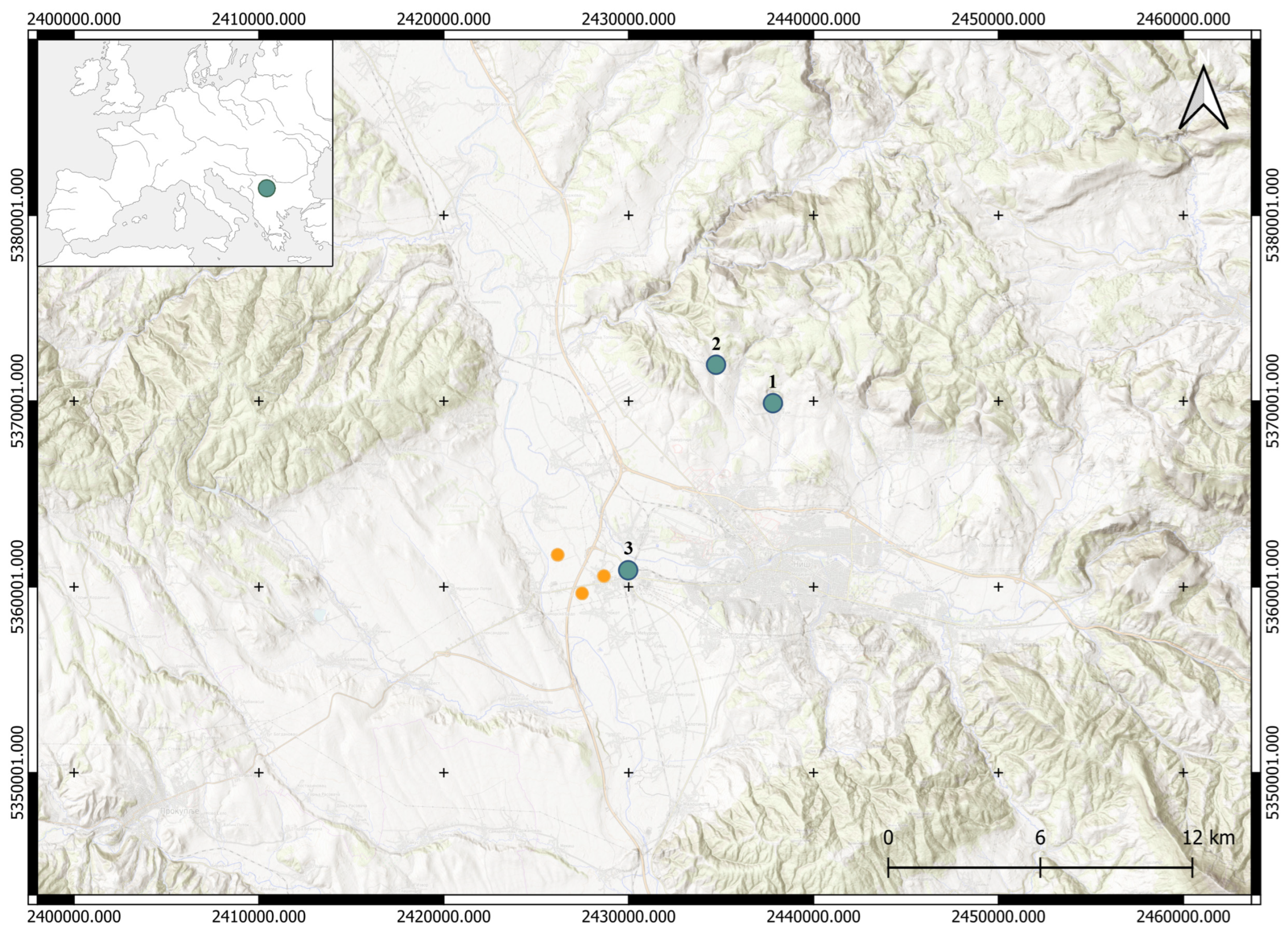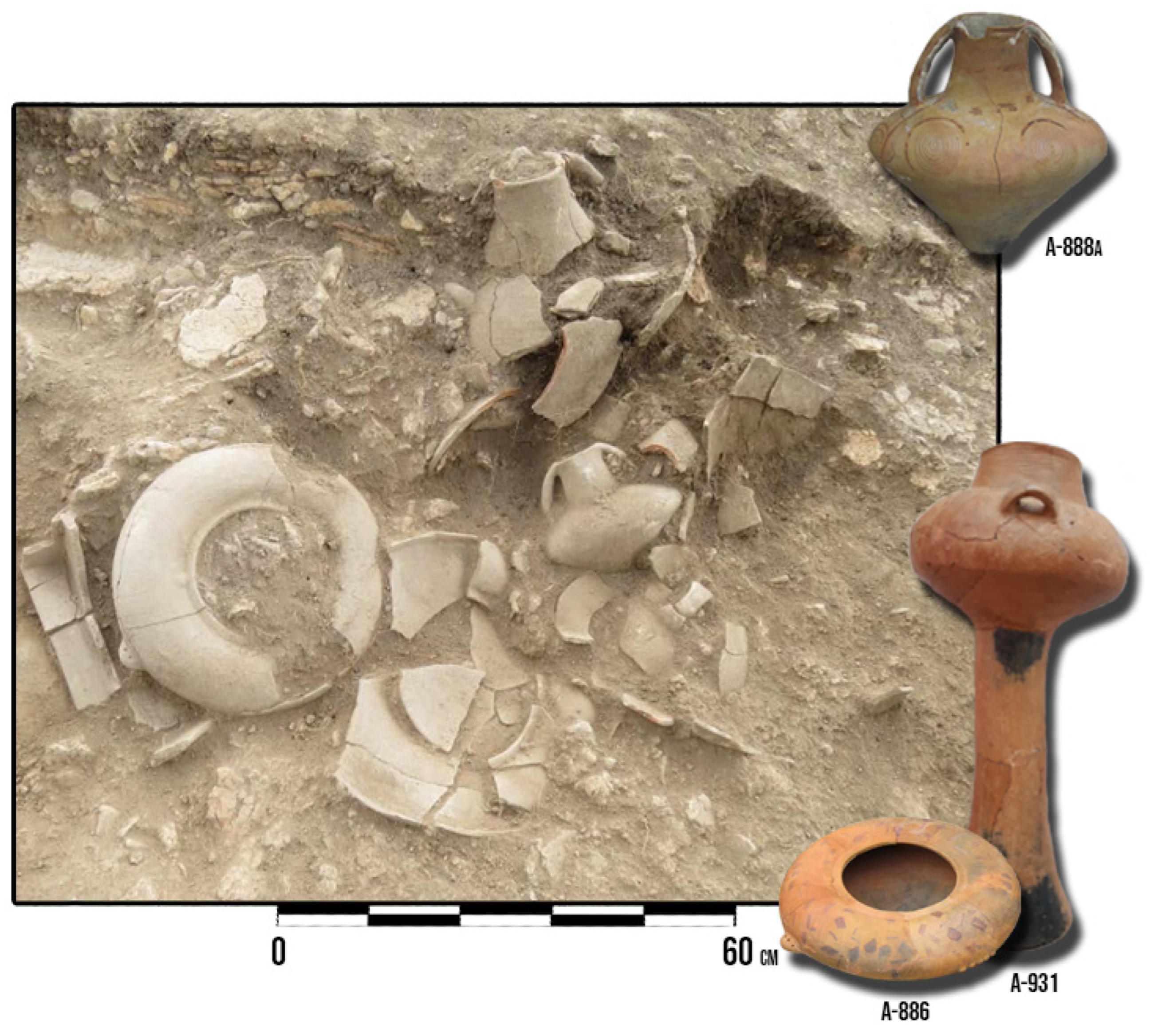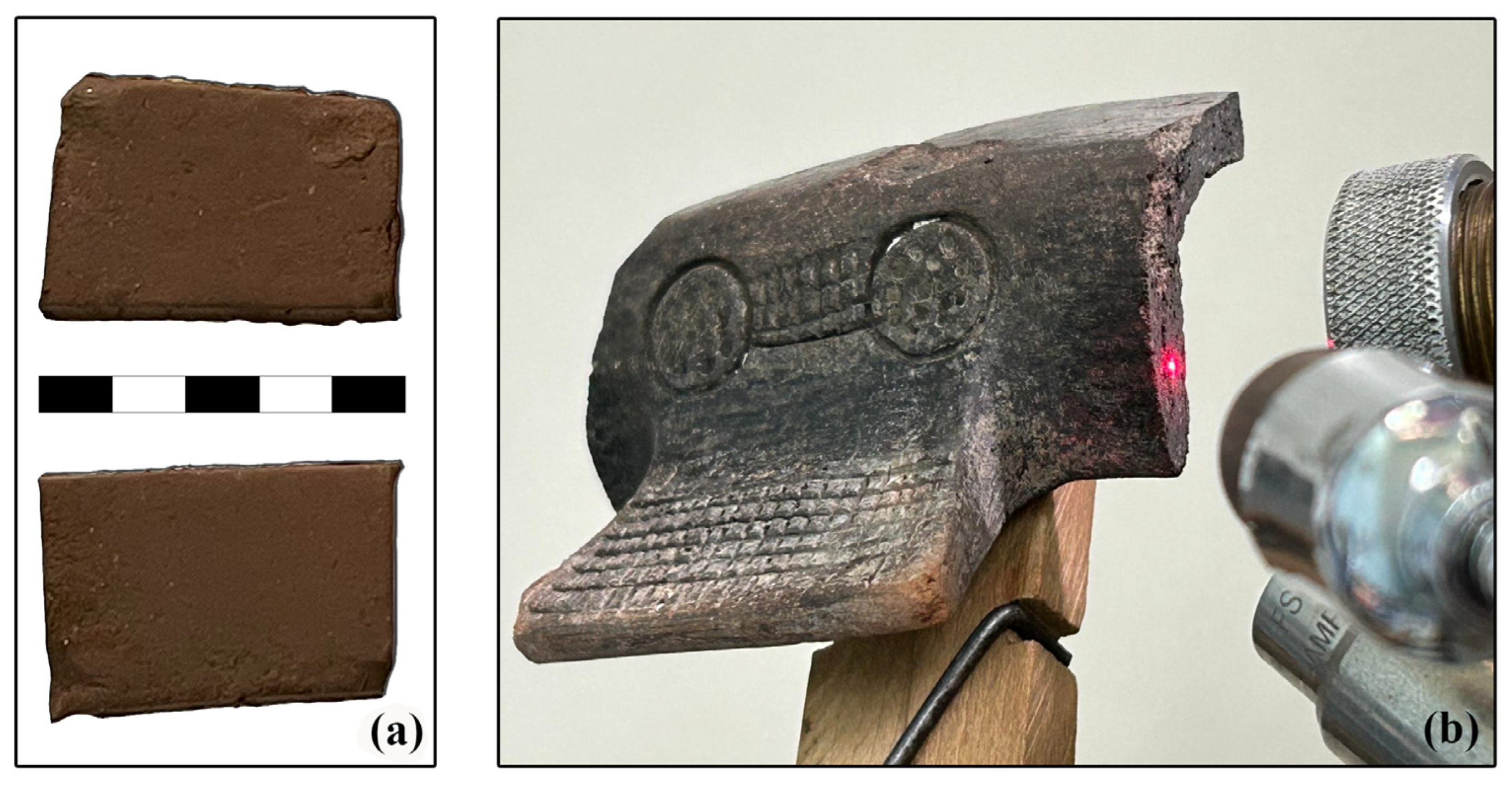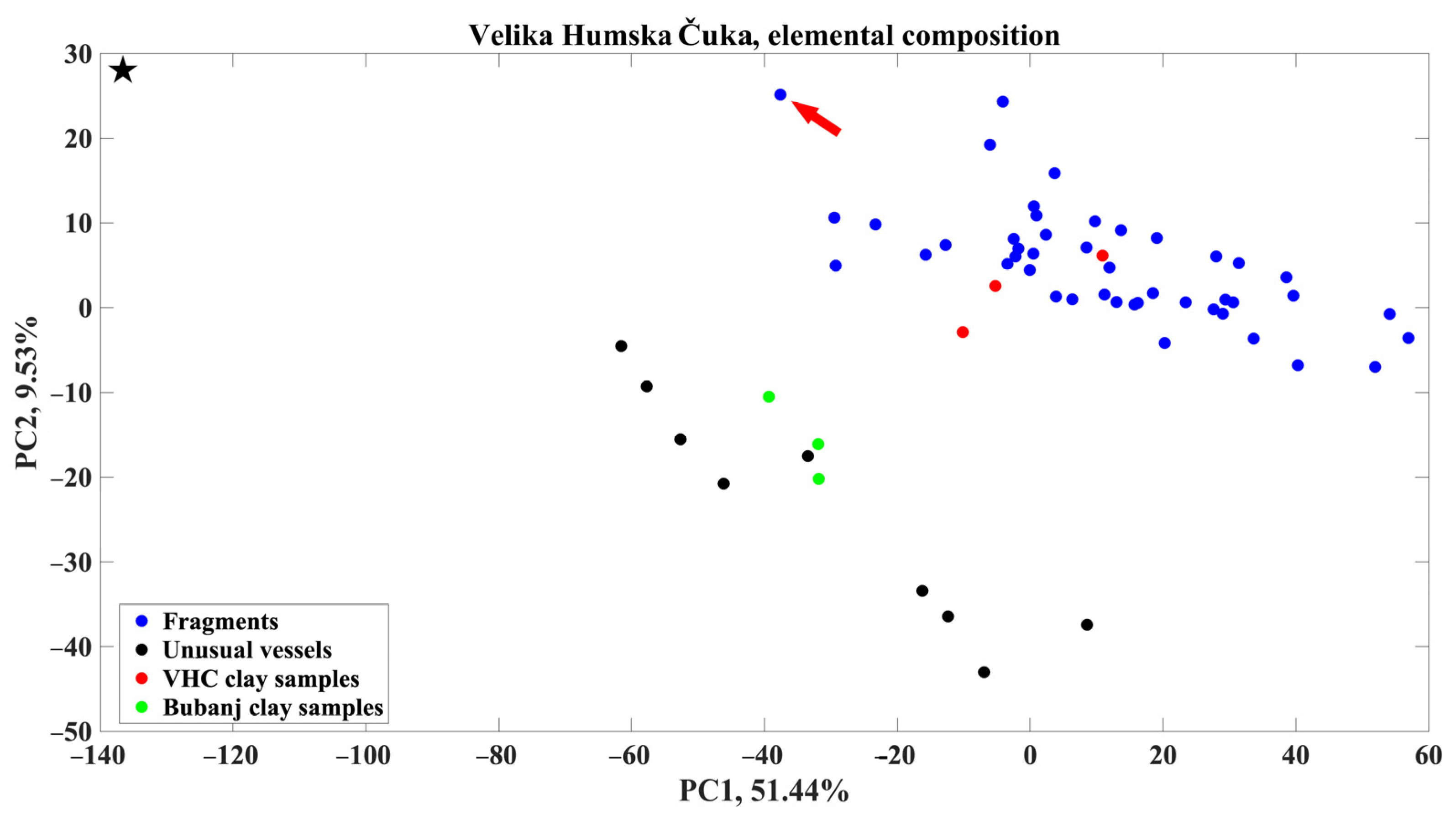Where Did Vessels Come from? A Study of Pottery Provenance from the Site of Velika Humska Čuka, Serbia
Abstract
1. Introduction
2. Materials and Methods
2.1. Samples
2.2. Sample Preparation
2.3. Analytical Technique and Data Analysis
3. Results and Discussion
4. Conclusions
Author Contributions
Funding
Institutional Review Board Statement
Informed Consent Statement
Data Availability Statement
Acknowledgments
Conflicts of Interest
References
- Garašanin, M.; Đurić, N. Bubanj i Velika Humska Čuka; Catalog; National Museum Niš: Niš, Serbia, 1983. [Google Scholar]
- Šarić, J. Kremenac, Donjepaleolitsko Nalazište; Institute of Archaeology: Belgrade, Serbia, 2013; ISBN 978-86-80093-85-7. [Google Scholar]
- Garašanin, M.; Garašanin, D. Arheološka Nalazišta u SRBIJI; Prosveta: Belgrade, Serbia, 1951. [Google Scholar]
- Garašanin, M.; Garašanin, D. Nova iskopavanja na Velikoj Humskoj Čuki kod Niša. Starinar 1959, IX–X, 243–254. [Google Scholar]
- Stojić, M.; Jocić, M. Niš Kulturna Stratigrafija Praistorijskih Lokaliteta u Niškoj Regiji; Institute of Archaeology: Belgrade, Serbia; National Museum Niš: Niš, Serbia, 2006; ISBN 9788680093253. [Google Scholar]
- Bulatović, A.; Milanović, D. Bubanj. The Eneolithic and the Early Bronze Age Tell in Southeastern Serbia; Austrian Academy of Sciences Press: Vienna, Austria, 2020; ISBN 978-3-7001-8451-5. [Google Scholar]
- Bulatović, A.; Gajić-Kvaščev, M.; Kapuran, A.; Ljuština, M.; Filipović, V.; Mladenović, O.; Milojević, P.; Milić, B. The Flow project—A contribution to the study of the cultural transmission of the Cental Balkan communities and the neighbouring regions in later prehistory. Archaeol. Sci. 2022, 18, 101–112. [Google Scholar] [CrossRef]
- Vlase, D.; Vlase, G.; Ursut, G.; Sfirloaga, P.; Manea, F.; Budiul, M.; Roatru, A.; Vlase, T. The in-depth study of Romanian prehistoric ceramics: Late Neolithic/Eneolithic pottery and clay materials from the Foeni Tell-Orthodox cemetery in Timis county. Ceram. Int. 2023, 49, 13941–14956. [Google Scholar] [CrossRef]
- Merk, V.; Berkh, K.; Rammlmair, D.; Pfeifer, L. Chemical and Mineralogical Analysis of Samples Using Combined LIBS, Raman Spectroscopy and µ-EDXRF. Minerals 2023, 13, 729. [Google Scholar] [CrossRef]
- Saraiva, A.S.; Coutinho, M.L.; Tavares da Silva, C.; Soares, J.; Duarte, S.; Veiga, J.P. Archaeological Ceramic Fabric Attribution Through Material Characterisation—A Case-Study from Vale Pincel I (Sines, Portugal). Heritage 2025, 8, 84. [Google Scholar] [CrossRef]
- Emmitt, J.J.; McAlister, A.J.; Phillipps, R.S.; Hodaway, S.J. Sourcing without sources: Measuring ceramic variability with pXRF. J. Archaeol. Sci. Rep. 2018, 17, 422–432. [Google Scholar] [CrossRef]
- Długosz-Lisiecka, M.; Sikora, J.; Krystek, M.; Płaza, D.; Kittel, P. Novel method of ancient pottery analysis based on radioactive isotope ratios: A pilot study. Herit. Sci. 2022, 10, 113. [Google Scholar] [CrossRef]
- Reedy, C.L.; Reedy, C.L. Micro-Computed Tomography with 3D Image Analysis to Reveal Firing Temperature Effects on Pore Systems in Archaeological and Ethnographic Ceramics. Appl. Sci. 2022, 12, 11448. [Google Scholar] [CrossRef]
- Gajić-Kvaščev, M.; Andrić, V.; Jančić-Heinemann, R.; Mladenović, O.; Bulatović, A. Comparison of Quantitative and Qualitative EDXRF Analysis for Provenance Study of Archaeological Ceramics. Materials 2024, 17, 3725. [Google Scholar] [CrossRef] [PubMed]
- Forster, N.; Grave, P.; Vickery, N.; Kealhofer, L. Non-destructive analysis using PXRF: Methodology and application to archaeological ceramics. X-Ray Spectrom. 2011, 40, 389–398. [Google Scholar] [CrossRef]
- Gliozzo, E. Ceramic technology. How to reconstruct the firing process. Archaeol. Anthropol. Sci. 2020, 12, 260. [Google Scholar] [CrossRef]
- Fukunaga, K. Introduction to Statistical Pattern Recognition, 2nd ed.; Academic Press Inc.: Cambridge, MA, USA, 1990; ISBN 0-12-269851-7. [Google Scholar]
- Varmuza, K.; Filzmoser, P. Introduction to Multivariate Statistical Analysis in Chemometrics; CRC Press Taylor & Francis Group: Boca Raton, FL, USA, 2009; p. 63. ISBN 978-1420059472. [Google Scholar]
- Brereton, R.G. Chemometrics: Data Analysis for the Laboratory and Chemical Plant; John Wiley & Sons, Ltd.: Hoboken, NJ, USA, 2003; p. 229. ISBN 978-0-470-84574-5. [Google Scholar]
- Bonizzoni, L. ED-XRF analysis for Cultural Heritage: Is quantitative evaluation always essential? J. Phys. Conf. Ser. 2015, 630, 012001. [Google Scholar] [CrossRef]
- Panchuk, V.; Yaroshenko, I.; Legin, A.; Semenov, V.; Kirsanov, D. Application of chemometric methods to XRF-data—A tutorial review. Anal. Chim. Acta 2018, 1040, 19–32. [Google Scholar] [CrossRef] [PubMed]
- Tasić, N. Badenski i Vučedolski Kulturni Kompleks u Jugoslaviji; Arheološko Društvo Jugoslavije: Belgrade, Serbia; Zajednica Muzeja Vojvodine: Novi Sad, Serbia, 1967. [Google Scholar]
- Dimitrijević, S. Vučedolska kultura i vučedolski kulturni kompleks. In Praistorija Jugoslavenskih Zemalja III. Eneolitsko Doba; Benac, A., Ed.; Centar za Balkanološka Ispitivanja: Sarajevo, Yugoslavia, 1979; pp. 267–341. [Google Scholar]
- Garašanin, M. Neolithikum und Bronzezeit in Serbien und Makedonien. Ber. Römisch-Ger. Komm. 1959, 39, 1–130. [Google Scholar] [CrossRef]
- Benkő, L.; Horvath, F.; Horvatnić, N.; Obelić, B. Radiocarbon and thermoluminescence dating of prehistoric sites in Hungary and Yugoslavia. Radiocarbon 1989, 31, 992–1002. [Google Scholar] [CrossRef]
- Durman, A.; Obelić, B. Radiocarbon dating of the Vučedol culture complex. Radiocarbon 1989, 31, 1003–1009. [Google Scholar] [CrossRef]
- Ciugudean, H.I. Eneoliticul Final in Transilvania si Banat: Cultura Cotofeni; Muzeul Național al Banatului: Timişoara, Romania, 2000; ISBN 973-585-178-4. [Google Scholar]
- Bulatović, A.; Gori, M.; Vander Linden, M. Radiocarbon dating the 3rd millennium BC in the Central Balkans: A re-examination of the Early Bronze Age sequence. Radiocarbon 2020, 62, 1163–1191. [Google Scholar] [CrossRef]
- Oršić-Slavetić, A. Bubanj, eine Prähistorische Ansiedlung bei Niš; Mitteilungen der prähist; Kommission der Akademie Wissenchaften: Vienna, Austria, 1940; pp. 1–42. ISSN 0065-5376. [Google Scholar]
- Bulatović, A.; Molloy, B.; Filipović, V. Serbia the Balkan-Aegean migrations revisited: Changes in material culture and settlement patterns in the Late Bronze Age Central Balkans in light of new data. Starinar 2021, LXXI, 61–105. [Google Scholar] [CrossRef]
- Bulatović, A.; Milanović, D. The cultural and chronological context of sites of Bubanj and Velika Humska Čuka near Niš (southeastern Serbia) and their significance for understanding the emergence and development of the Central Balkans eneolithic. Bull. Mosc. Reg. State Univ. 2021, 36–64. [Google Scholar] [CrossRef]
- Raczky, P. The Cultural and Chronological Relations of the Tisza Region During the Middle and Late Neolithic as Reflected by the Excavations at Öcsöd-Kováshalom. 1988. Available online: https://www.researchgate.net/publication/292447339_The_cultural_and_chronological_relations_of_the_Tisza_region_during_the_Middle_and_Late_neolithic_as_reflected_by_the_excavations_at_Ocsod-Kovashalom (accessed on 20 February 2025).
- Jovanović, B.; Salkuta, I.V.; Krivodol; Bubanj, J. James Harvey Gaul in Memoriam; Stefanovich, M., Todorova, H., Hauptmann, H., Eds.; J. Harvey Foundation: Sofia, Bulgaria, 1988; pp. 197–202. ISBN 9544910263/978-9544910266. [Google Scholar]








Disclaimer/Publisher’s Note: The statements, opinions and data contained in all publications are solely those of the individual author(s) and contributor(s) and not of MDPI and/or the editor(s). MDPI and/or the editor(s) disclaim responsibility for any injury to people or property resulting from any ideas, methods, instructions or products referred to in the content. |
© 2025 by the authors. Licensee MDPI, Basel, Switzerland. This article is an open access article distributed under the terms and conditions of the Creative Commons Attribution (CC BY) license (https://creativecommons.org/licenses/by/4.0/).
Share and Cite
Gajić-Kvaščev, M.; Mladenović, O.; Milojević, P.; Bulatović, A. Where Did Vessels Come from? A Study of Pottery Provenance from the Site of Velika Humska Čuka, Serbia. Materials 2025, 18, 1083. https://doi.org/10.3390/ma18051083
Gajić-Kvaščev M, Mladenović O, Milojević P, Bulatović A. Where Did Vessels Come from? A Study of Pottery Provenance from the Site of Velika Humska Čuka, Serbia. Materials. 2025; 18(5):1083. https://doi.org/10.3390/ma18051083
Chicago/Turabian StyleGajić-Kvaščev, Maja, Ognjen Mladenović, Petar Milojević, and Aleksandar Bulatović. 2025. "Where Did Vessels Come from? A Study of Pottery Provenance from the Site of Velika Humska Čuka, Serbia" Materials 18, no. 5: 1083. https://doi.org/10.3390/ma18051083
APA StyleGajić-Kvaščev, M., Mladenović, O., Milojević, P., & Bulatović, A. (2025). Where Did Vessels Come from? A Study of Pottery Provenance from the Site of Velika Humska Čuka, Serbia. Materials, 18(5), 1083. https://doi.org/10.3390/ma18051083








